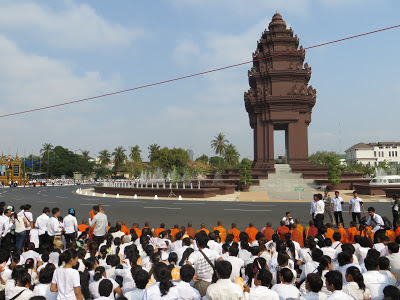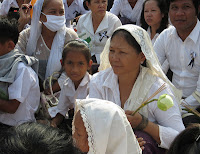“All radios and TV stations as well as entertainment places
must suspend broadcasting joyful spectacles,” read the decree signed by
Cambodian Prime Minister Hun Sen.
For three months now, truckloads of mourners have been
driving the dusty roads into the capital.
They have come from all across Cambodia, from the cities and from the
countryside. They wear formal white
shirts and black silk sarongs and trousers.
They have driven up the central boulevards and along the
quay. Bringing pink-tipped lotus buds
and bundles of incense, they come to sit in front of the Grand Palace to pay homage
to the late King Father Norodom Sihanouk, former King of Cambodia.
I arrived in Cambodia not long after the King Father had
passed away, from a heart attack, in Beijing at the age of 89. The country was in mourning. Large images of Sihanouk draped in black and
white ribbons were everywhere across Phnom Penh. In the public park across from the royal
palace construction proceeded at a rapid rate, as a red and gold stupa fit for
a king’s cremation took form.
We have now come to the final days of mourning, the official
seven days spanning the opening week of February. No music or TV shows may broadcast episodes
that might make one laugh. Silky blue and red flags fly half mast, circling
ferries on the Tonle Sap have switched off their engines, and the city’s main
arteries are blockaded against the usual swell of traffic. The boulevards to the palace feel only the
pad of thousands of feet.
Early on the first of February, I donned a white blouse and
a black pleated skirt – a school uniform borrowed from my roommates – and
headed out to the center of the city to attend the King’s funeral procession.
We drove as far as roadblocks would permit. Police congregated at the gates allowing in
only those who were dressed in white and black and to whose chests were pinned
black and white ribbons some bearing color pictures of the king. One of my students was wearing a grey
sweatshirt over her formal clothing. A
police officer stopped her in the road with a reprimand. He pointed at me, “See even the foreigners
pay their respects.” Chagrinned, she
stuffed the jacket into her bag and only then were we allowed to pass the
barricades and walk on foot up Norodom Boulevard to the towering mauve
Independence Monument.
It was a morning of waiting.
We sat on the grass as the day grew hotter and the crowd larger. But the atmosphere, despite the numbers, was
subdued: thousands of men and women and children, all in black and white, on
the grass and on the roads encircling the monument. They talked, they sat quietly, they prayed, they
cried.
Across the city thousands of people were doing the same –
not just along the roads of the procession, but in the central meeting places
of the city, where 14 large screens had been erected to broadcast the march of
the King Father’s body.
Monks in brilliant orange congregated in groups and crouched
near the front of the crowd. Spaced
along the six-kilometer route teams of 90 monks sat waiting to chant final
blessings as the king’s coffin passed.
Police officers and older army officers paced along the
empty road. Women skirted the edges of
the crowd hawking lotus blossoms and sticks of incense. Boys carried Styrofoam trays filled with
black and white ribbons. On a grass
median we fanned ourselves with orange cellphone fans that had been passed out
to the quiet crowd. We sat and
waited. And then walked and waited.
Somewhere farther north, many blocks up, the king’s body was
making its final tour of Phnom Penh. The
cremation ceremony, which according to the government costs 1.2 million dollars (but
others speculate ran to 5 million), began at 8:10 with the Royal Cambodian
Armed Forces piercing the muggy air with a 101-gun artillery salute. Preceded by flocks of startled pigeons, the
funeral procession began a march up the packed but quiet streets of Phnom Penh towards
the towering stupa of Wat Phnom.
The four-day funeral ceremony follows, as precisely as
possible, documents detailing the funerals of past Cambodian kings –stretching
from the 20th century all the way back to the processions held to
honor the Angkor kings 800 years ago and inscribed in carvings in Siem
Reap. Only small nods to modernity have
been allowed – a metal funeral pyre has replaced wood ones and there is no
longer a parade of elephants through the streets of Phnom Penh.
Down at Independence Monument we listened to updates over
the loudspeakers. We sat with a woman who shared with us cobs of boiled
corn. Helicopters circled overhead – one
so low to the ground that the crowd was buffeted by wind and grit.
Despite the hundreds of thousands of people spread along the
main roads there was no crush, no shouting, no pushing. Over the loud speakers the approach of the
procession was trumpeted and, with a communal sigh, the crowd kneeled. We kneeled, knees to the gritty pavement. And we waited. A young man looking back as I shifted weight
passed me one of his flip-flops to kneel on.
With the sound of drums the procession rounded the
monument. Subdued and stately, men and
women in colorful uniforms marched praying crowd: members of the army, members
of the navy, members of the Red Cross youth, members of the Royal Palace
staff. Glittering floats headed with
tens of mythical nagas carrying the king’s crown, floats shaped as the mythical
– Hamsas – bird bearing members of the royal family, members of parliament. A delegation of Cambodian Muslims dressed in
white playing long stringed instruments, a delegation of Cambodian Chinese clashing
cymbals, a delegation of the ethnic minority from the forested Ratanakiri
Province. The young man on whose shoe I
was kneeling leaned back, “All Cambodians, from all communities come to honor
the King.”


For an American with a firm belief in democracy, such
displays of grief for a monarch might be unnerving. Having lived for some time in the neighboring
monarchy of Thailand, I have garnered an appreciation for the power of a King
in the eyes of his subjects.
Who was Norodom Sihanouk?
Norodom Sihanouk was crowned King of Cambodia in 1941 in the
midst of World War II at the age of 19. It was a time for young kings – neighboring
Thailand would put the teenage Bhumibol Adulyadej on the throne four years
later.
For Cambodians the king father is larger than life, but even
for those who are dubious about the power of monarchy his accomplishments are
impressive.
Most notably, it was under King Sihanouk that Cambodia won independence from France. But his
reign was not velvet lined. In the 1950’s
he chose to abdicate the throne to become Cambodia’s first prime minister,
leading Cambodia into twenty years of peace and development.
Cambodia's growth and peace were shattered by the geo-political strife of the Cold War, and particularly the Vietnam War. Aligning himself with communist China, the King found himself ousted by a United States backed coup d'etat against him. Shortly after being reinstated through an alliance with the Khmer Rouge, Pol Pot turned against him, holding him hostage for the remainder of the regime. He would lose five of his fourteen children to the war and genocide. After the Vietnamese invasion, he lived in exile in North Korea and in China, finally to be reinstated as King and then finally to abdicate a second time in 2004 in favor of his son, the present King
Norodom Sihamoni.
It has been six turbulent decades for the Kingdom of
Cambodia.
And then, as we kneeled on the ground of the road, the
king’s coffin, bedecked in jasmine flowers floated past. Past the chanting monks, past the military
dignitaries, past the thousands of mourners from the city and from the countryside,
past the towering monument to the Independence King Sihanouk won from France over
fifty years ago.
On Saturday I walked all the way to the Palace along the
quay. The day was hot, the sun strong,
but still mourners covered the grass, congregating in pockets of shade, taking
pictures next to the parked floats of gilded nagas. Some have been here for days, sleeping out in
cardboard boxes to be close to their king.
Several old Buddhist nuns have not left the palace since the
day in October when the King’s body was returned to Cambodia from Beijing.

At the entrance to the cremation site a line was forming,
and – because no one stopped me – I joined the queue. As we
reached the front there was a slight commotion with guards deciding whether
foreigners would be allowed entrance.
“I’m sorry you are journalists, you have big cameras you can’t enter.”
Then “only foreigners with papers can enter”.
Then “we are checking.” Then “I’m sorry no foreigners can enter.” About to leave, a high-ranking police officer
strode over to the small collection of foreigners: “What are they doing? Of
course they must be allowed to enter.
Let them through.”
The site of the cremation shines in new paint. From an aerial view on television, it takes
on the appearance of poor CGI effects.
The ground is a flat-toned yellow, the roofs a matte red with painted
lines to suggest tiles. Large displays
of white plastic roses are everywhere.
Quietly we were ushered around the central crematorium,
kneeling with the crowd in respect, the jasmine covered coffin high above us.
I returned to the palace Monday evening – the night of the
cremation. Thousands of mourners filled
the park leading up to the Palace. Food
sellers laid mats on the sidewalks and busied themselves cooking skewers of
meat and boiled baby ducks still in the shell (a local favorite.) There were corn sellers and cotton candy
sellers and men and women peddling laminated images of the king.
On this last day the cremation site was reserved for the
dignitaries: The French Prime Minister, the Japanese Prince, senior officials
from China and from other Southeast Asian countries.
Present too were 405 former prisoners – former drug sellers
and thieves, some accused of rape and some accused of murder, but all pardoned
and released in honor of the cremation.
Their first free steps were to pay respect to the King Father.
Barricades were erected on the street running the length of
the palace. As the sky darkened we knelt again on the road amidst thousands and
waited.
I know, but I did not see, that the King of Cambodia,
Norodom Sihamoni, and the Queen Mother gave the final prayer through tears and
carried candles to light the pyre. I did
not see the body of the King Father turn to ash. Neither did the people of Cambodia, for in
the final moments flowing white curtains enclosed the gold coffin shielding the
conflagration from view.
A 101-gun artillery salute broke the mournful quiet,
followed by the bursting of fireworks along the Tonle Sap. The crowd clambered to its feet pointing
upwards as the first billows of smoke rose up into the night sky, over the
palace and outwards over Phnom Penh.





















